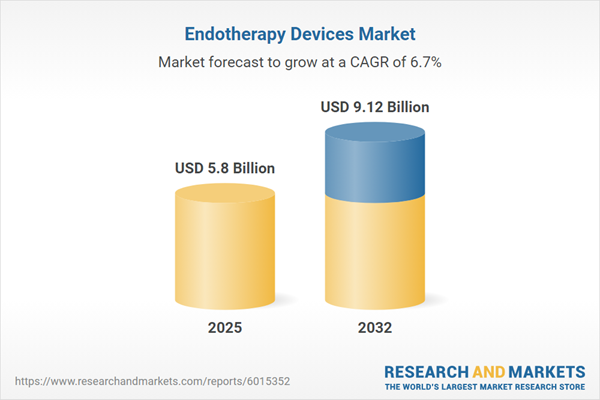Speak directly to the analyst to clarify any post sales queries you may have.
Senior executives navigating the endotherapy devices market must balance innovation, regulatory shifts, and evolving operational needs. Access to advanced insights allows leaders to formulate agile strategies, foster resilience, and position their organizations effectively amid sector change.
Market Snapshot: Endotherapy Devices Market
The endotherapy devices market is set on a strong growth trajectory, forecast to advance from USD 5.43 billion in 2024 to USD 5.80 billion in 2025 and reach USD 9.12 billion by 2032, at a projected CAGR of 6.69%. This evolution is driven by increased uptake of sophisticated endoscopic technologies and widespread adoption of patient-centric healthcare models. Adapting regulatory policies, a shift towards single-use solutions, and ongoing advancements in visualization are reshaping clinical standards. In response, market leaders continually adjust their portfolios, adopting approaches that enhance business continuity and identify new opportunities across global markets.
Scope & Segmentation
- Product Types: Capsule endoscopes as well as both reusable and single-use flexible and rigid endoscopes, each targeting specific infection control and healthcare application needs.
- Applications: Devices support a range of procedures including arthroscopy, gastrointestinal (upper and lower tract) interventions, pulmonary diagnostics, and urological endoscopy, broadening the clinical scope and procedural adaptability.
- End Users: Hospitals, clinics, and ambulatory surgical centers leverage modular design and integration features to streamline care pathways and enhance operational efficiency.
- Distribution Channels: Procurement is enabled by direct tenders and established distributor-wholesaler partner networks, facilitating tailored device acquisition for both hospital systems and outpatient care providers.
- Technologies: Incorporation of three-dimensional imaging, advanced high-definition optics, and narrow band imaging augments procedural visualization, supporting optimal clinical decisions and improving patient safety during endotherapy.
- Regions: The Americas, Europe, Middle East & Africa, and Asia-Pacific exhibit diverse adoption patterns, influenced by reimbursement environments, healthcare infrastructure, and local policy developments.
- Key Companies: Competitive dynamics and innovation stem from the participation of Olympus Corporation, Boston Scientific Corporation, Medtronic plc, Johnson & Johnson, Cook Medical LLC, KARL STORZ SE & Co. KG, Fujifilm Holdings Corporation, CONMED Corporation, ERBE Elektromedizin GmbH, and Pentax Medical Company, Ltd., who continue to shape industry standards.
Key Takeaways for Senior Decision-Makers
- Advanced imaging and visualization are shifting procurement and device selection, prompting senior healthcare leaders to reassess multi-disciplinary purchasing strategies and clinical workflows.
- Growing interest in single-use endoscopes reflects a sector-wide focus on minimizing infection risk while maintaining seamless operations across multiple facilities.
- Strengthening local supply relationships and building durable regional partnerships enhances supply chain resilience, improving response times and reducing operational risk.
- Alignment of business strategies with regional reimbursement structures and regulatory requirements is essential for unlocking scalable growth within variable healthcare ecosystems.
- Collaboration with digital health and analytics technology providers enables the integration of next-generation solutions, advancing clinical outcomes and supporting data-driven care.
- Strategic alliances, including targeted mergers and partnerships, underpin expanded product portfolios and greater market access, meeting evolving provider demands for comprehensive endotherapy platforms.
Impact of 2025 United States Tariffs
Anticipated US tariffs in 2025 are leading endotherapy device manufacturers to rethink sourcing and distribution strategies. By prioritizing domestic supplier relationships and adopting just-in-time inventory practices, businesses aim to manage costs and minimize supply chain disruptions. Enhanced collaboration with US-based partners further supports predictable delivery and mitigates exposure to pricing volatility.
Methodology & Data Sources
This research blends perspectives from clinicians, procurement experts, and device manufacturers, complemented by in-depth reviews of academic publications, regulatory briefings, and insights from major industry events. A scenario-based approach and data triangulation process ensure the delivery of reliable, strategic insights for executive decision-making in the endotherapy devices market.
Why This Endotherapy Devices Market Report Matters
- Delivers a grounded overview of market innovation, regulatory changes, and shifts in care standards, informing executives’ development of sustainable strategies.
- Strengthens investment planning, market positioning, and risk management as organizations adapt to evolving technology and healthcare delivery models.
- Enables senior leaders to recognize and navigate regional market opportunities and operational challenges, advancing partnerships and facilitating scalable growth.
Conclusion
This report empowers senior decision-makers with focused analysis and actionable guidance, supporting confident leadership and strategic agility as the endotherapy devices market continues to evolve.
Additional Product Information:
- Purchase of this report includes 1 year online access with quarterly updates.
- This report can be updated on request. Please contact our Customer Experience team using the Ask a Question widget on our website.
Table of Contents
3. Executive Summary
4. Market Overview
7. Cumulative Impact of Artificial Intelligence 2025
Companies Mentioned
The companies profiled in this Endotherapy Devices market report include:- Olympus Corporation
- Boston Scientific Corporation
- Medtronic plc
- Johnson & Johnson
- Cook Medical LLC
- KARL STORZ SE & Co. KG
- Fujifilm Holdings Corporation
- CONMED Corporation
- ERBE Elektromedizin GmbH
- Pentax Medical Company, Ltd.
Table Information
| Report Attribute | Details |
|---|---|
| No. of Pages | 182 |
| Published | October 2025 |
| Forecast Period | 2025 - 2032 |
| Estimated Market Value ( USD | $ 5.8 Billion |
| Forecasted Market Value ( USD | $ 9.12 Billion |
| Compound Annual Growth Rate | 6.6% |
| Regions Covered | Global |
| No. of Companies Mentioned | 11 |









